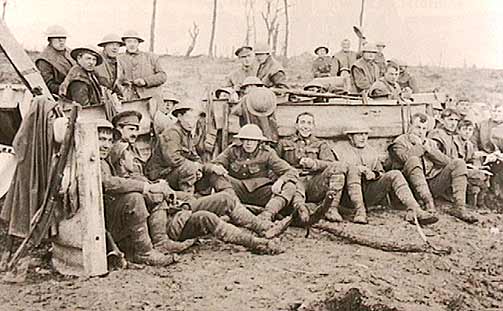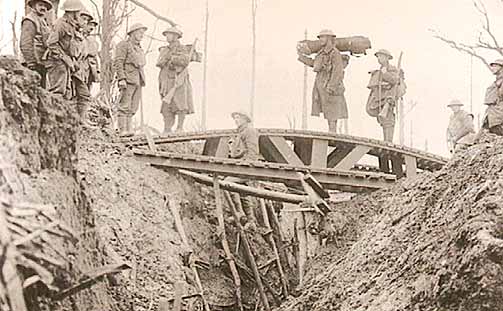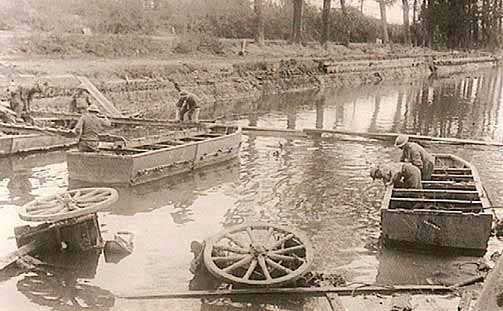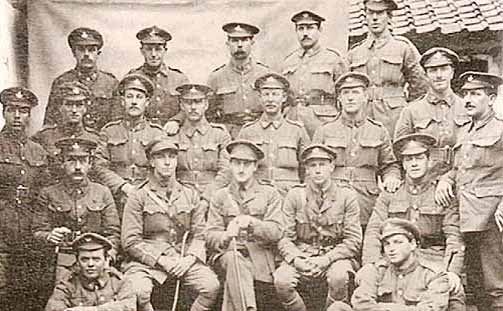|
When the Labour Corps was formed in
mid 1917 it was decided that the men assigned to it from other
regiments, often because of their reduced medical category,
should change their regimental badges to that of the
General Service Corps. Many of the men disliked having
to wear this badge and preferred to retain their regimental
identity. Towards the end of 1918 the Labour Corps was granted
their own badge - the piled pick, rifle and shovel emblem
that was to become the badge of the Pioneer Corps (later
Royal Pioneer Corps). Once it had been created, the Labour
Corps was split into various Labour groups, each consisting
of a headquarters and several Labour companies. In addition
there were Area Employment Companies, Area Employment (Artisan)
Companies, Divisional Employment Companies, and Agricultural
Companies.
Special Labour units were not fully
mobile and were limited to a geographical area. They were
called Employment Companies. They were identified by another
prefix - Area, Divisional, Corps or Army. Area Coys were located
in a specific town undertaking the routine tasks etc and they
never moved. Divisional and Corps Companies were attached
to the relevant Headquarters and moved with that unit. They
were only employed in the unit and consisted of lower graded
men who were physically less capable to the standard Labour
Companies. The personnel included, clerks, batmen, runners,
cooks in messes, Divisional Concert Party, sock depot, laundry
and bath units and also supplied men to the sanitary and salvage
sections. These men were working in the units prior to the
formation of the Labour Corps and had no organised establishment
or chain of command so they were all transferred under the
Labour Corps.
The company establishment was two officers,
one company Quarter Master Sergeant, 270 NCOs and Privates,
an Orderly Room Clerk and a Batman. Normal Labour companies
were commanded by a Major and consisted of some 425 men. The
company role was a varied one including running the divisional
baths, laundry, cinema, stores and officers mess as well as
acting as divisional police and undertaking guard duty. Within
the company there were specialists such as tailors, shoemakers,
butchers and telephone operators.

• Men of the 22/Durham Light
Infantry Pioneer battalion pose for the
camera during a break from their labours near Maurepas in
December 1916.

• Pioneers of the 11/Liverpool
enjoying an alfresco meal in exposed
conditions near Ypres in December 1917. Note the regimental
badge on some helmets.
Although initially considered non-combatants,
the British companies of the Labour Corps often performed
their duties in forward areas, often under heavy fire. In
the spring of 1918 the Corps assumed combatant status for
dealing with the last German offensive of March 1918. Throughout
the summer of that year the men of the Labour Corps units
in the forward areas worked fully armed and some served as
fighting soldiers when need arose. However the vast majority
of men continued to work in unarmed companies. Life in the
Labour Corps could be as bad as that enjoyed by front line
troops; they were often under continual shellfire for months
at a time. Indeed 2,300 men in the Labour Corps were either
killed in action or died of wounds between May 1917 and the
end of the war.

• Constructing and erecting
trench bridges were frequent tasks for the Pioneer battalions.
This is a standard trench bridge crossing former German trenches
at Gommecourt.
Pioneer battalions, created
as an expedient in 1914, were a new concept in the British
Army. Intended to provide the Royal Engineers with skilled
labour and to relieve the infantry from some of its non-combatant
duties, Pioneers became the work horses of the Expeditionary
Forces. The Coldstream Guards and over three dozen County
regiments, each created at least one pioneer battalion. Several
new Army battalions were raised specifically as Pioneers,
while others were converted Territorials or Kitchener units
formed originally as conventional infantry. Adopting a badge
of a cross rifle and pick, these battalions wired, dug and
revetted in all weathers and in all terrains. On many occasions
they abandoned their working tools and fought alongside the
infantry in repelling enemy attacks. In their efforts to stem
the German offensives of 1918, several Pioneer units fought
themselves to virtual annihilation. The work of the Pioneer
battalions has been largely ignored or misunderstood. Far
from being the units of the aged and infirm, these sixty eight
battalions played a major role in the Allied victory.

• Pioneers of the 10/DCLI constructing
a pontoon
bridge over the canalised River Scheldt in October 1918.
Many thousands of Chinese men were
recruited to serve in the Labour Corps. Many of them were
shipped to France via the west coast of British Columbia,
Canada. The foreign units of the Labour Corps, including the
prisoners of war, were not supposed to be posted near the
front line. However, there are many war graves in France and
Flanders that bear Chinese lettering, the resting place of
Labour Corps workers, mostly killed by shellfire. When the
war ended in November 1918, the Labour Corps continued their
support role and were also involved in salvage work, grave
and burial registration and as Prisoner of War guards.

• After a gruelling period on
the Somme, the concert party of the 11/DLI posed for
this picture at Picquigny in October 1916. Captain G S Fillingham
(centre) was
posted from the regular 2/DLI. He recalled:
'A typical pioneer job
was this - be present under shell fire all day in support
of the main attack.
Then move forward and grab ground and dig trenches in so called
no man's land under enemy
fire at night. Go back before day break, sleep and start all
over again. Casualties no object'.
By the end of the war the Labour Corps
had a strength of about 380,000 men stationed in the UK, in
France and Flanders, Italy, Egypt and Salonika. In fact the
size of the Corps reached its greatest of almost 400,000 in
Jan 1919. This included about 240 Labour Companies in France
and Flanders with about thirty to fifty Labour Companies allocated
to each of the first, second, third, fourth and fifth armies,
with a few kept aside as lines of communication units. There
were about the same number of companies serving elsewhere
overseas at area, divisional, corps and army level as well
as some 400 or so companies working in the UK. In late 1918
and early 1919 there were Labour Companies numbered from 1
to over 1000, with little evidence of their origin. The Labour
Corps was disbanded late in 1919.
In 1937, as part of the general planning
for war provision was made for a special labour force to consist
of Infantry and Cavalry reservists to be formed in groups
and companies under the general administration of the Royal
Engineers. Some of these formations landed in France within
the first weeks of World War 2 in September 1939.
In WW2 the Labour Corps was reformed
but due to the association with Labour it was named Auxiliary
Military Pioneer Corps on 17 October 1939 out of the six
group headquarters and 48 companies then existing, who had
been sent to France with the BEF in the first week of the
war. The units were the same as the Labour Companies in WW1
but no Employment Companies were formed as the HQ had their
own establishment and personnel working within depots etc
were drawn from Pioneer Companies. Direct enlistment into
the Corps began that day. In December 1939 a Director of Auxiliary
Pioneer Services was appointed who worked under the Director
of Recruiting and Organisation. Enemy Aliens were recruited
into the Pioneer Corps and over 10,000 Germans, Austrians
and Italians were recruited. Some fought in BEF in 1939, 1940.
They served in Alien Companies but by 1942 when their loyalty
was confirmed many were allowed to transfer to the Fighting
Arms (No 10 Command and the 2 Pathfinder Parachute Companies)
were all Germans. Many were commissioned into all three services.
In November 1939 the War Office approved a badge for the Corps. Described as:- A rifle, a shovel and a pick ‘piled’ on them a laurel wreath, all ensigned with a crown. Beneath, the motto Labor Omnia Vincit (Work Conquers all). The badge was not designed for the Pioneer Corps but was approved in October 1918 for the Labour Corps which was formed in 1917 and disbanded in 1919.
In July 1940 a Brigadier was appointed
as Inspector, Auxiliary Military Pioneer Corps. In August
1940 the Quartermaster General proposed that a Labour Directorate
should be formed under his department. The existing appointments
were abolished. Brigadier ALI Friend, who had been inspector
of the AMPC was appointed Director and Inspector of Labour
with a staff of a 1 ADL, 1 DADL and 2 Staff Captains. The
Corps rapidly expanded as the Services' need for a larger
labour force became apparent. The title was changed to Pioneer
Corps in 1940.
In November 1940 the Colonel Commandant,
Field Marshall Lord Milne, pointed out that the title Auxiliary
Military Pioneer Corps was extremely unpopular with all ranks
and bad for esperite de corps. At the same time it was agreed
that Companies should be armed on 100% scale instead of 25%
which has previously been the case. Training centres were
quickly formed to receive, clothe and equip recruits and personnel
posted from other Arms Companies were formed and dispatched
as required, this being the normal unit allotted to meet labour
requirements. It was usually to consist of about 280 men divided
into 10 sections of 26 men and a small HQ. Each section was
commanded by a Sgt. Two sections were commanded by a Lieutenant.
A number of companies (between 4 and 20) within a geographical
area would be commanded by a Group HQ under a Lieutenant Colonel.
In addition to UK troops, Pioneers
were enlisted from the Commonwealth and included Swazis, Basutos,
Buchuanas, East and West Africans, Mauritians, Rodriguais
and Seychellois, Sinhalese, Indians of all classes, Cypriots
and Maltese. Syrians, Palestines and Arabs also joined the
Corps. In addition, in NW Europe, Free French, Dutch and Belgian
Companies of Pioneers were formed.
Worldwide, wherever labour was required
to keep the military machine in operation, including control
and administration of civilian labour in support of the Forces,
Pioneers played their part with distinction. When called upon
the Corps took its place alongside the infantry - in France
etc. Wherever Pioneers served
commanders paid tribute to their work and contribution to
final victory. During the war there was practically no task
that was not performed by Pioneers. The Corps handled all
kinds and types of stores and ammunition, built camps, airfields
and fortifications, cleared rubble and demolished roadblocks,
built roads, railways and bridges, loaded and unloaded ships,
trains and planes, constructed aircraft pens against enemy
bombing and a host of other jobs.
It is true to say that there was no
British theatre of war in the world where Pioneers were not
to be found. In November 1942 Pioneers made their first amphibious
landing in North Africa with the First Army and earned a great
name during the six months campaign. One Company went into
the line as infantry for three weeks and acquitted itself
with great credit.
|
